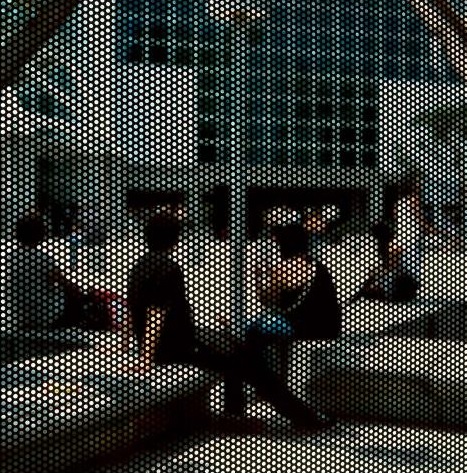
Anthony Hernandez
American, 1947-
Screened Pictures #1, 2017-2018
inkjet print
55 1/2 × 55 1/2 × 2 in.
SBMA, Museum purchase, Eric A. Skipsey Acquisition Fund
2019.17

Undated photo of Anthony Hernandez, SFMOMA
“My work may be beautiful or it might not be, that just isn’t what I am concerned with. I try to be open and face the city... To me it’s not unpleasant or unbeautiful, it’s just life—which has to be threatening sometimes if it is going to be interesting.” - Anthony Hernandez
COMMENTS
"Screened Pictures" consists of portraits of Los Angeles as seen through the metal mesh of the various different bus stops throughout the city. The scenes are abstracted and offer a different perspective of the city than his earlier works—giving off a digital appearance even though they are all taken on film and have not been digitally manipulated. "Screened Pictures" brings forth a shift back to figures in Hernandez’s photographs as well. Different from his earlier series, his figures are now blurred through the inherent abstraction of the metal grating and his choice to focus the camera consistently on the metal mesh rather than the background. Upon closer examination of the photographs, visual cues inform the viewer as to what they could be looking at: a tent perched on the edge of a patch of grass, a lone figure walking in front of a gas station, and various different architectural details from throughout the city. All of these bring to mind certain aspects of Hernandez’s other series, yet this revisitation is from a completely different perspective. “LA is my big studio,” Hernandez has said. “One day I’m in one corner, the next in the middle…it’s like having a filter to see LA in a new way.”
Anthony Hernandez first began photographing in 1966 with a 35mm camera. His early works consisted of black and white street photography that were solemn and pensive. After receiving a grant from the National Endowment for the Arts, Hernandez purchased a large-format camera and began photographing urban landscapes and public spaces. He then made his first color work, "Rodeo Drive" (1984) photographing shoppers with a 35mm camera on the famed street in Beverly Hills for which the series is named. His later series would differ greatly as he shifted away from photographing figures that were central to the image itself, rather focusing on the spaces that they inhabited and the scenes that followed. Within each body of work Hernandez acknowledges the implied cultural differences of class and race that is inherent to the city.
Hernandez’s subject matter is born out of Los Angeles itself—a documentation of the common places that are accessible to all but also seldom used. Los Angeles is a city of erasure and through his photographs Hernandez is able to capture a persistent feeling of loss. His pictures are often devoid of figural representation yet rampant with their lingering presence. The minimal and mindful framing of each image made Hernandez’s photographs “as charged as tarot cards,” according to critic Luc Sante. His photographing of public transit areas is one that he has returned to often, first in his series "Public Use Areas" (1980) and now again in "Screened Pictures" (2017/2018).
Anthony Hernandez (b. 1947) lives and works in Los Angeles, CA and Idaho. He was most recently included in "May You Live in Interesting Times" curated by Ralph Rugoff as part of the 58th International Art Exhibition of La Biennale di Venezia and is subject to a solo-exhibition at the Nelson-Atkins Museum, Kansas City, MO. Hernandez was subject to his first career retrospective that traveled to the San Francisco Museum of Modern Art (2016), the Milwaukee Art Museum, WI (2017), and the Fundación MAPRE in Madrid, Spain (2019). In 1998 Hernandez was awarded the Rome Prize, and in 2018 he received the Guggenheim Memorial Fellowship. His work resides in permanent collections such as the Getty Center, the Hammer Museum, LACMA, and the Museum of Contemporary Art (all Los Angeles); the Met, Museum of Modern Art, the Whitney, and the Guggenheim Museum (all New York); the San Francisco Museum of Modern Art, and the Tate Modern in London, amongst others.
https://www.kaynegriffin.com/exhibitions/anthony-hernandez
SBMA CURATORIAL LABELS
Los Angeles-based artist Anthony Hernandez depicts LA’s landscape via inventive, sometimes disorienting, means. Here Hernandez aimed his lens through the gridded holes of an LA bus stop screen, challenging a viewer’s perception and photography’s supposedly transparent recording of the world. Two figures sit on diagonally-placed benches, gazing onto a plaza with the façade of a 1980s-looking post-modernist building. This building’s grid pattern contrasts with the bus stop’s scrim of circles, creating a moiré pattern that makes abstract what otherwise would be clearly visible, and that comes into focus only from a distance. In this way Hernandez’s work resembles the Pointillism of French Post-Impressionist Georges Seurat (1859-1891). Similar to Seurat with his paintings of river banks, Hernandez takes a public space as his subject. Bus stops are not new in Hernandez’s work: a 1980s series featured small groups of riders waiting for busses in the greater Los Angeles area. Like this 2017-18 photograph, this earlier series presents life as lived in Southern California far from the Hollywoodized version of LA as a care-free paradise.
- The Lens of Architecture, 2022
